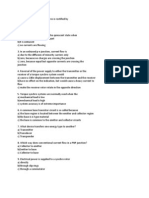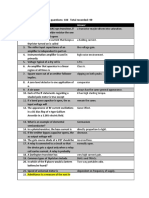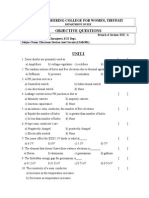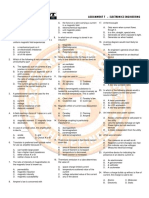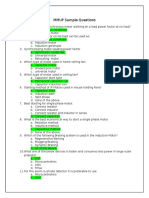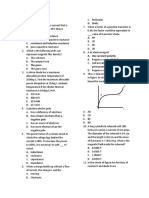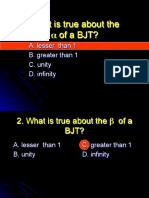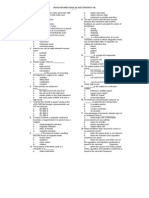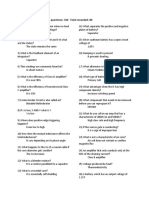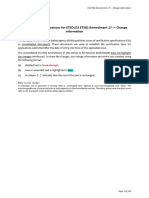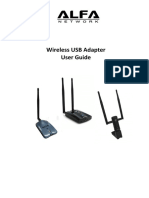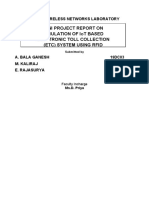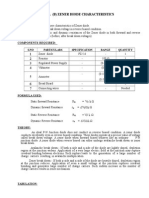Objective Questions - Basic Electrical and Electronics Engineering
SECTION I: Multiple Choice Questions (MCQs)
1. The synchronous speed of a 6-pole, 50 Hz induction motor is:
(a) 500 rpm (b) 750 rpm (c) 1000 rpm (d) 1200 rpm
2. Which type of loss in a transformer is minimized by using laminated cores?
(a) Copper loss (b) Eddy current loss (c) Hysteresis loss (d) Both (b) and (c)
3. The P-N junction diode conducts current when it is:
(a) Forward biased (b) Reverse biased (c) Both forward and reverse biased (d) Not biased at all
4. The depletion region in a P-N junction contains:
(a) Free electrons only (b) Holes only (c) No mobile charge carriers (d) Both free electrons and holes
5. The threshold voltage of a silicon diode is approximately:
(a) 0.3V (b) 0.7V (c) 1.1V (d) 1.5V
6. Zener diodes are primarily used for:
(a) Rectification (b) Voltage regulation (c) Power amplification (d) Signal modulation
7. An example of a non-linear element is:
(a) Diode (b) Resistor (c) Inductor (d) Capacitor
8. The majority charge carriers in an NPN transistor are:
(a) Holes (b) Electrons (c) Both (d) None
9. The current gain in a common-emitter configuration is represented as:
(a) beta (b) alpha (c) gamma (d) delta
10. The base-emitter junction in an active transistor is:
(a) Forward biased (b) Reverse biased (c) Unbiased (d) None
11. The slip in an induction motor is defined as:
(a) Ratio of rotor speed to synchronous speed (b) Difference between rotor and synchronous speed
(c) Difference between synchronous and rotor speed divided by synchronous speed (d) None of the above
12. A DC generator converts:
(a) Electrical energy to mechanical energy (b) AC to DC (c) Mechanical energy to electrical energy (d)
None of the above
13. A capacitor filter is used in rectifiers to:
(a) Reduce voltage (b) Improve efficiency (c) Reduce ripple (d) Increase current
14. The Zener breakdown occurs due to:
(a) High forward voltage (b) Heavy doping (c) Light doping (d) Increase in temperature
�15. The efficiency of a full-wave rectifier is approximately:
(a) 40.6% (b) 81.2% (c) 100% (d) 50%
16. In a bridge rectifier, the number of diodes used is:
(a) 1 (b) 2 (c) 3 (d) 4
17. A MOSFET differs from a JFET because:
(a) JFET has a higher input impedance (b) MOSFET has an insulated gate
(c) JFET cannot operate in enhancement mode (d) Both (b) and (c)
18. The main application of MOSFETs is in:
(a) Power amplifiers (b) Switching circuits (c) Low-noise applications (d) All of the above
19. The region where a transistor operates as a switch is:
(a) Active (b) Cutoff (c) Saturation (d) Both (b) and (c)
20. The enhancement-mode MOSFET requires:
(a) No gate voltage (b) A negative gate voltage (c) A positive gate voltage (d) A constant current source
SECTION II: Fill in the Blanks
1. The torque produced in a 3-phase induction motor depends on ______ and rotor current.
2. In a synchronous generator, the frequency of the generated voltage depends on the number of poles and
______.
3. A diode allows current to flow in ______ direction.
4. The threshold voltage of a germanium diode is approximately ______ V.
5. The width of the depletion region ______ when a diode is forward biased.
6. A Zener diode operates in ______ breakdown region.
7. A BJT has three terminals: ______, ______, and ______.
8. The ______ configuration has the highest current gain in a BJT.
9. In an NPN transistor, the collector current is mainly due to ______ charge carriers.
10. The relation between alpha and beta is given by beta = ______.
11. The speed of an induction motor is slightly ______ than synchronous speed.
12. The losses occurring due to the resistance of winding in a transformer are called ______.
13. The ripple factor of a full-wave rectifier is ______.
14. A filter circuit is used in rectifiers to reduce ______ in the output voltage.
15. The number of diodes required for a bridge rectifier is ______.
16. The ______ diode is used for voltage regulation in power supplies.
17. In a MOSFET, the ______ terminal is insulated from the channel by an oxide layer.
�18. The ______ mode MOSFET requires a positive gate voltage to turn ON.
19. The pinch-off voltage in a JFET is the voltage at which the ______ is completely closed.
20. MOSFETs are widely used in ______ circuits due to their low power consumption.





